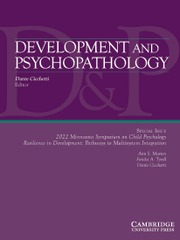Article contents
Frontal brain electrical activity in infants of depressed and nondepressed mothers: Relationto variations in infant behavior
Published online by Cambridge University Press: 01 September 1999
Abstract
In previous studies, infants of depressed mothers have been found to exhibit reduced leftfrontal brain electrical activity (EEG). The left frontal region has been hypothesized to mediatesocial approach behaviors and positive affective expression. These findings raise importantquestions about the cause and nature of atypical EEG patterns in infants of depressed mothers.The present study begins to address some of these questions by examining whether or notvariations in patterns of frontal brain activity in infants of depressed and nondepressed mothersare related to variations in infant behavior as observed in naturalistic situations. If such relationsexist, are they specific to certain behaviors hypothesized to be mediated by the frontal region(i.e., positive approach behaviors)? Frontal and parietal brain electrical activity was recordedfrom 14- to 15-month old infants of depressed versus nondepressed mothers during a baselinecondition and during conditions designed to elicit interest and positive affect. Infant behaviorwas observed in naturalistic play conditions, with and without mother, on a separate day fromEEG testing. Mothers provided information on infant temperament. Infants of depressed mothersshowed less affection and touching of their mothers. For infants of depressed mothers only,reduced left frontal brain activity was found to be related to lower levels of affection towardmother, but not to infant temperament. Furthermore, increased generalized frontal activation wasfound to be related to higher levels of negative affect, hostility, and tantrums and aggression.Relations between infant brain activity and behavior were not found for parietal EEG activity.These results suggest that infant frontal electrical brain activity is related to variations in infantbehavior, especially those involved in positive affiliative behavior and the expression andregulation of negative affect. The nature and cause of atypical patterns of brain activity andquestion of whether such atypical patterns of frontal brain activity predispose infants to affectivedisorders in later life are discussed.
Information
- Type
- Research Article
- Information
- Copyright
- © 1999 Cambridge University Press
- 62
- Cited by

